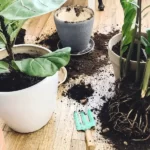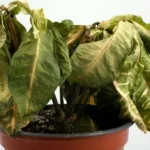What is root rot?
Root rot is a common plant disease that affects the roots of a plant. It is caused by overwatering, which leads to soggy soil, poor drainage, or high humidity. Root rot can be identified by the yellowing, wilting foliage, slow growth, and eventual death of the plant.
Common causes
The most common causes of root rot are:
- Overwatering or excessive moisture in the soil
- Poor drainage due to dense, compacted soil
- High humidity levels
- Fungal pathogens such as Pythium, Phytophthora, Rhizoctonia, and Fusarium
Symptoms
Plants suffering from root rot exhibit several distinctive symptoms including:
- Wilting, drooping leaves and foliage
- Slow growth or lack of new growth
- Yellowing leaves
- Leaf drop
- Smaller than normal leaves
- Stunted growth
Upon inspecting the roots, you may see brown, mushy roots that feel soft or hollow. Healthy roots should be firm and white.
Why it’s harmful
Root rot is extremely harmful because it prevents the plant from absorbing water and nutrients through its root system. Without healthy roots, the plant is unable to transport water throughout its system via the xylem and transpiration. This leads to the eventual death of the plant if left untreated.
Causes of Root Rot

Root rot can be caused by a number of factors which create an environment conducive to fungal growth.
Overwatering
The most common cause of root rot is overwatering your plants. Excess moisture in the soil suffocates roots leading to decay. Roots require oxygen to function, so saturated soil inhibits this.
Poor drainage
Dense, compacted soil prevents excess water from draining properly after watering or heavy rain. Standing water leads to oxygen deprivation.
Compacted soil
Soil that is excessively compacted or dense does not allow proper water or air circulation to the roots. Heavy soils like clay are more prone to compaction.
High humidity
Consistently high humidity provides the moist environment that many fungal pathogens need to proliferate and attack roots. Poor air circulation contributes to this.
Fungal pathogens
Root rot is often caused by fungal organisms such as Pythium, Phytophthora, Rhizoctonia, and Fusarium. These pathogens thrive in moist conditions.
Symptoms of Root Rot

It’s important to identify root rot early. Here are the most common visible symptoms:
Wilting
One of the first signs of root rot is visible wilting and drooping of leaves and branches, despite regular watering. This is due to the damaged roots’ inability to take up water.
Yellowing leaves
As root rot advances, you’ll notice yellowing of the leaves, starting with the lowest, oldest leaves first before progressing to the younger growth. Leaf margins may brown.
Drooping foliage
The stems and foliage will start to take on a drooping, unattractive appearance as the plant declines and loses turgidity.
Slow growth
Affected plants exhibit slow growth and a lack of new shoots or leaves. Existing foliage may be abnormally small.
Root discoloration
Inspecting the roots will reveal light brown, grey, or black roots that feel mushy. Healthy roots are firm and white.
Preventing Root Rot

Root rot can be prevented by following good cultural practices:
Water properly
Water thoroughly until it runs from the drainage holes, but allow the soil to partially dry out between waterings. Never let plants sit in soggy soil.
Improve drainage
Amend dense soil with compost to improve drainage and aeration. Consider planting in raised beds.
Add compost to soil
Work compost into soil to improve texture and drainage. Compost inoculates soil with beneficial microbes that protect roots.
Control humidity
Ensure greenhouse or indoor plants have adequate air circulation and ventilation. Dehumidifiers can help lower humidity.
Disinfect tools
Disinfect shears and other gardening tools to prevent spreading pathogens between plants. Dip tools in a 1:9 bleach-water solution.
Remove affected plants
Uproot and discard plants with severe root rot to prevent spread. Do not compost infected plants.
Treating Root Rot

If caught early, root rot can sometimes be treated:
Remove affected roots
Carefully wash soil from roots to inspect and remove any brown, mushy roots. Trim off damaged areas until only clean, white roots remain.
Replant in new soil
Repot the plant in new, sterile potting mix to prevent reinocitation. Choose a pot with drainage holes.
Apply fungicide drench
Water plants with a fungicide like Subdue or Banrot following label instructions to kill pathogens in soil. Retreat every 5-7 days.
Improve growing conditions
Repotting provides an opportunity to amend soil and improve drainage. Only water when partially dry. Increase sunlight and airflow.
Conclusion
Summary
Root rot is a destructive condition that affects plant roots leading to wilting, yellowing, slow growth, and death. It is most commonly caused by overwatering and overly moist soil which enables fungal pathogens to proliferate. Prevent root rot by watering appropriately, amending soil, controlling humidity, and following sanitation practices. Plants with mild to moderate rot may recover if afflicted roots are removed and environmental conditions improved.
Prevention is key
The best way to deal with root rot is to prevent it in the first place. Allow soil to dry out between waterings, improve drainage, provide good air circulation, and disinfect tools. Catching root rot early also improves the chances of saving affected plants. With proper care, most plants can thrive without suffering from this harmful condition.
FAQs
What plants get root rot?

Almost any plant can get root rot if overwatered, but some species prone to it include orchids, Christmas cacti, gardenias, poinsettias, begonias, and African violets. Most vegetables like tomatoes and peppers are susceptible as well.
How do you fix root rot?

Fix root rot by inspecting roots, removing any that are brown or mushy, repotting in fresh sterile soil mix, applying a fungicide drench, and improving growing conditions by amending soil and ensuring adequate sunlight and air circulation.
Can plants recover from root rot?

If more than 50% of the roots are healthy, the plant has a good chance of recovery, but improvement will be gradual. The younger the plant, the better its odds. Severe rot on a mature plant may be fatal.
How can I improve drainage?
To improve drainage, amend heavy soil with compost or perlite. Use containers with drainage holes. For in-ground plants, ease compaction and create raised beds to improve drainage.
What’s the best soil for drainage?
The best potting mixes for drainage are lightweight, soilless mixes that contain peat moss, perlite, bark chips and coconut coir. For in-ground planting, amend soil with compost or peat to lighten texture. Add sand if soil is very dense.

2 thoughts on “Root Rot: Identification, Causes, Prevention, and Treatment”